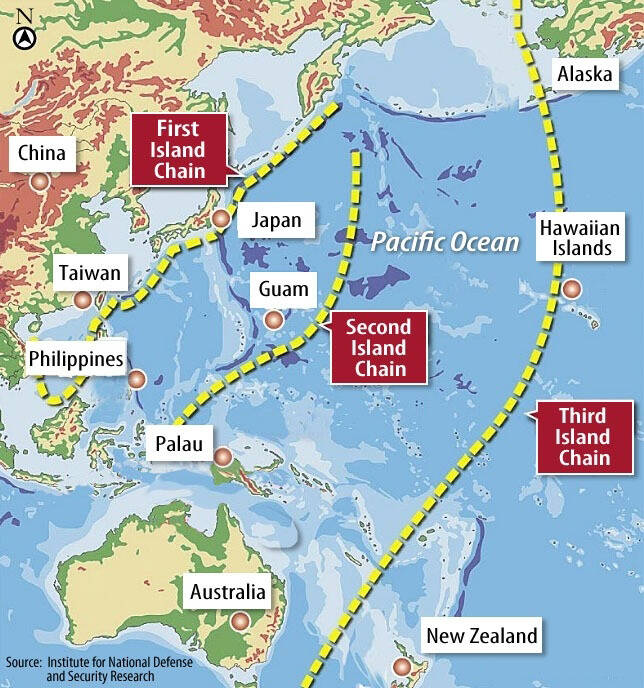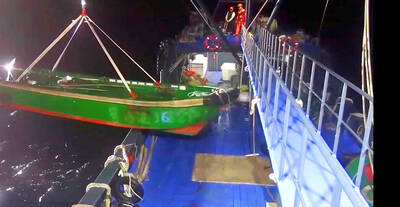The US Marine Corps (USMC) has introduced new anti-drone systems to bolster air defense in the Pacific island chain amid growing Chinese military influence in the region, The Telegraph reported on Sunday.
The new Marine Air Defense Integrated System (MADIS) Mk 1 is being developed to counter “the growing menace of unmanned aerial systems,” it cited the Marine Corps as saying.
China has constructed a powerful defense mechanism in the Pacific Ocean west of the first island chain by deploying weapons such as rockets, submarines and anti-ship missiles — which is part of its anti-access/area denial (A2/AD) strategy against adversaries — the report said.

It is transforming the swathe of the ocean from Japan to the Philippines into a dangerous “no man’s land” that could deter the US and allied forces from entering, while Chinese forces would have greater freedom of movement, it said.
To counteract Beijing’s A2/AD deployment along the first island chain, the Marine Corps is establishing new littoral regiments, which would execute “island hopping” strategies to counter Chinese warships with mobile anti-ship missiles, the report said.
MADIS would be mounted on two Joint Light Tactical Vehicles.
One vehicle would be equipped with a machine gun, a 30mm autocannon and a launcher for Stinger infrared-guided anti-aircraft missiles ranging up to 8km, the report said.
The other vehicle would carry a radar and command suite that detects targets and directs an engagement, it said.
MADIS is a key component of the Marine Corps’ modernization strategy and is compatible with new equipment, such as General Atomics’ MQ-9 surveillance drones, mobile surveillance radars and robotic launchers for Naval Strike Missile anti-ship missiles, the report said.
The Marine Corps in 2020 was reorganized to facilitate its modernization, including retiring traditional heavy weapons such as main battle tanks and building three littoral 2,000-person regiments, it said.
Although the reform at first encountered internal resistance, it has borne fruit and become exemplary for the US’ Pacific allies, the report added.
The 3rd Marine Littoral Regiment’s MADIS fired at target drones in the training exercises performed in Hawaii on Jan. 25, it said.
MADIS markedly enhanced littoral regiments’ tactical flexibility by enabling them to detect and defend the airspace without relying on other branches of the armed forces, the report cited the marine corps as saying.
Such self-reliance is critical, as the regiments could be divided into battalions or companies and must operate alone at their island outposts even when surrounded by enemies, it said.
Therefore, the Marine Corps’ strategy emphasizes the importance of emissions control, or radio silence, while the littoral troops are deployed, the report said.
Ideally, Chinese naval forces would enter a MADIS’ missile range without noticing the Marine Corps’ deployment, but still the littoral troops must be capable of independent operations at their isolated outposts, it said.
They cannot expect the US Navy or US Air Force to riskily enter China’s A2/AD zone to rescue them if Chinese drones come snooping, the report said.
MADIS is considered a “last-ditch defense,” but frontline Marine Corps troops might have to employ it more often than expected, as threats from Chinese forces are rising in the West Pacific, it said.

Taiwan yesterday condemned the recent increase in Chinese coast guard-escorted fishing vessels operating illegally in waters around the Pratas Islands (Dongsha Islands, 東沙群島) in the South China Sea. Unusually large groupings of Chinese fishing vessels began to appear around the islands on Feb. 15, when at least six motherships and 29 smaller boats were sighted, the Coast Guard Administration (CGA) said in a news release. While CGA vessels were dispatched to expel the Chinese boats, Chinese coast guard ships trespassed into Taiwan’s restricted waters and unsuccessfully attempted to interfere, the CGA said. Due to the provocation, the CGA initiated an operation to increase

A crowd of over 200 people gathered outside the Taipei District Court as two sisters indicted for abusing a 1-year-old boy to death attended a preliminary hearing in the case yesterday afternoon. The crowd held up signs and chanted slogans calling for aggravated penalties in child abuse cases and asking for no bail and “capital punishment.” They also held white flowers in memory of the boy, nicknamed Kai Kai (剴剴), who was allegedly tortured to death by the sisters in December 2023. The boy died four months after being placed in full-time foster care with the

A Taiwanese woman on Sunday was injured by a small piece of masonry that fell from the dome of St Peter’s Basilica in the Vatican during a visit to the church. The tourist, identified as Hsu Yun-chen (許芸禎), was struck on the forehead while she and her tour group were near Michelangelo’s sculpture Pieta. Hsu was rushed to a hospital, the group’s guide to the church, Fu Jing, said yesterday. Hsu was found not to have serious injuries and was able to continue her tour as scheduled, Fu added. Mathew Lee (李世明), Taiwan’s recently retired ambassador to the Holy See, said he met

The Shanlan Express (山嵐號), or “Mountain Mist Express,” is scheduled to launch on April 19 as part of the centennial celebration of the inauguration of the Taitung Line. The tourism express train was renovated from the Taiwan Railway Corp’s EMU500 commuter trains. It has four carriages and a seating capacity of 60 passengers. Lion Travel is arranging railway tours for the express service. Several news outlets were invited to experience the pilot tour on the new express train service, which is to operate between Hualien Railway Station and Chihshang (池上) Railway Station in Taitung County. It would also be the first tourism service